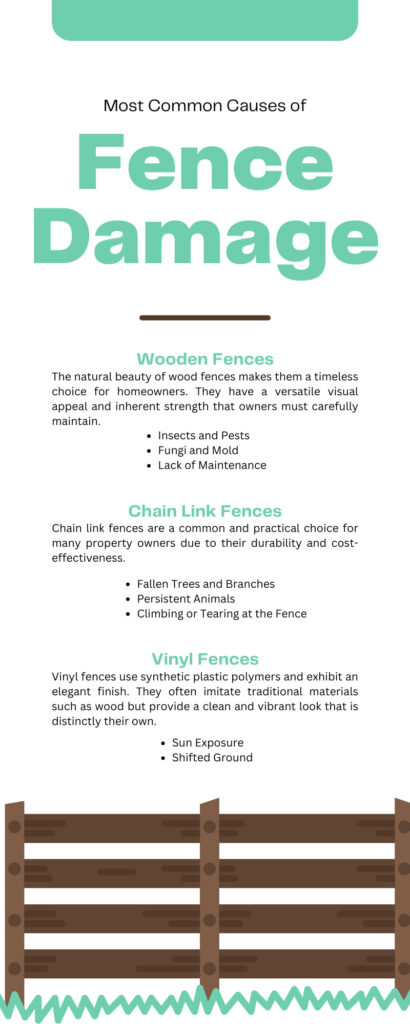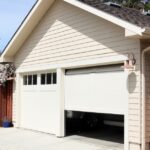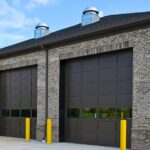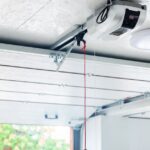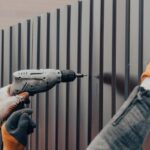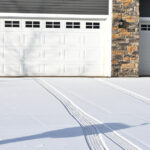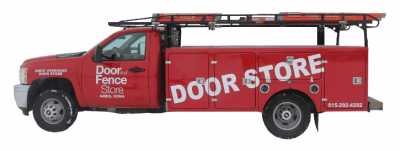A fence stands tall, marking the boundaries of your property, protecting your home from unwanted visitors, and adding to your home’s aesthetic appeal.
However, have you noticed your original resilient fence has lost its strength and charm? Perhaps it’s leaning, rotting, or sporting visible holes and cracks.
It’s not an uncommon sight; fences require upkeep. Let’s review the 10 most common causes of fence damage based on the fencing material you have installed on your property.
Wooden Fences
The natural beauty of wood fences makes them a timeless choice for homeowners. They have a versatile visual appeal and inherent strength that owners must carefully maintain.
Insects and Pests
Termites, beetles, carpenter ants, and wood-boring insects can infest and cause devastating damage to the fence over time. These pests are attracted to rotted wood and moist environments. If you do not take preventative measures, you’re at a higher risk of suffering an insect infestation.
Fungi and Mold
Microorganisms thrive in moist conditions; they can quickly colonize wood surfaces if left unchecked. Over time, the decay process leads to structural weakness in the fence, causing it to crack, crumble, or fall apart.
Fungi and mold also degrade the fence’s once-aesthetic appeal with unsightly discolorations and growths. Regular maintenance and mold-resistant treatments are essential protective measures for prolonging the life of wooden fences.
Lack of Maintenance
If you want to prevent mold, fungi, insects, and other pests, you’ll need to implement excellent maintenance techniques for your wooden fence. Poor maintenance results in splintered wood, rotting, fading from UV rays, and loss of structural stability.
Routine applications of waterproof paints, stains, and sealants will prevent the risk of rotted wood and moisture. It will act as a protective barrier to keep the strength of the wood and the sumptuous appeal intact.
Chain Link Fences
Chain link fences are a common and practical choice for many property owners due to their durability and cost-effectiveness. These fences feature zinc-coated steel wires with polyester protection. The wires weave together to form a diamond pattern, offering a sturdy barrier without obstructing the view.
Fallen Trees and Branches
Trees and branches can fall during strong winds or extreme storms and because of the natural aging process of trees. The weight and impact of these falling objects can bend or snap the links of the fence, warp the poles, or flatten entire sections.
Persistent Animals
Animals such as raccoons, squirrels, and even deer can cause significant harm to your fencing. Raccoons and squirrels, with their sharp claws and teeth, can chew or tear through the fence fabric, creating holes or weak spots. Deer may charge into fences to cause dents or broken links.
This damage compromises the structural integrity of your fence and provides an entry point for other pests. Implementing animal deterrents, regularly checking for damage, and initiating prompt repairs can help mitigate this issue.
Climbing or Tearing at the Fence
Time naturally wears down chain link fences. They will start to droop on their own. However, children climbing on the rails and pets chewing at the chains can put immense pressure on the structure. The fence will lose its visual appeal as well as its structural integrity from this excessive tension.
Vinyl Fences
Vinyl fences use synthetic plastic polymers and exhibit an elegant finish. They often imitate traditional materials such as wood but provide a clean and vibrant look that is distinctly their own. Vinyl is a distinguished choice for those seeking a versatile fence that requires minimal maintenance and stunning style.
Sun Exposure
Ultraviolet (UV) rays from the sun can have a detrimental effect on vinyl materials over time, leading to discoloration, brittleness, and cracks. This issue is UV degradation, a common problem faced by many outdoor fixtures.
Although manufacturers often treat vinyl fences with a UV stabilizer to slow this process, over time, the effectiveness of this treatment can wane, leaving the fence vulnerable to sun damage. Consider applying a UV protective sealant, which can extend the life of your vinyl fence and keep it looking fresh and vibrant.
Shifted Ground
Over time, natural events such as soil erosion, ground settlement, and even minor earthquakes can lead to shifts in the ground. This ground movement can exert pressure on the fence posts, causing them to lean, twist, or even crack.
Additionally, in areas prone to freezing temperatures, the freeze-thaw cycle can lead to a phenomenon known as frost heave. This occurs when the ground significantly moves and results in similar damage.
Proper installation is key for mitigating the effects of shifting ground on your vinyl fence. In addition to deeper post holes and gravel usage, you can also consider adding concrete around the posts for added stability. Regularly inspecting the fence and making adjustments as needed, such as tightening screws or replacing damaged panels, can help maintain its integrity over time.
Ornamental Fences
Ornamental steel fences are one of the strongest fence materials that also provide luxurious curb appeal. These low-maintenance, long-lasting fences offer incredible security qualities without compromising on elegance.
Temperature Fluctuations
The constant expansion and contraction of steel due to temperature fluctuations can impose stress on the fence structure. This stress can result in deformations, weakened joints, and, in severe cases, cracks in the metal. Temperature fluctuation issues are especially pronounced in regions with significant seasonal temperature variations.
Temperature fluctuations can also compromise the stability of any protective coatings. In return, the metal may be at further risk of rusting.
Excessive Moisture
A common source of damage to ornamental steel fences is excessive moisture. Prolonged exposure to wet conditions can lead to the formation of rust, a type of corrosion that occurs when iron in the steel reacts with oxygen and water. Rust mars the appearance of the fence with a reddish-brown discoloration while progressively eating away at the metal.
Areas with high rainfall or humidity levels are particularly susceptible to this issue. Sprinkler systems that frequently drench the fence can also be a concern.
It’s crucial to apply a protective coating to the steel that repels water and prevents rust. You may even try to dry off the fence after a heavy rainstorm or sprinkler cycle to minimize direct contact with water.
What Are Your Fencing Options?
The most common causes of fence damage are bothersome to tackle on your own. Let the Door and Fence Store alleviate the stress by offering our services to your home.
If your fence is an inefficient, worn-down eyesore, the Door and Fence Store has options. We offer each of the fencing styles listed above at our locally owned and operated shop. You can choose a brand-new design to embellish your home’s curb appeal and improve its security.
The next option is to seek repair from our team of fencing experts. We understand that not every piece of damage requires complete replacement. For the slightest imperfections, we’ll evaluate the issue and fix it up so that your fence looks incredible at a fraction of the cost.
